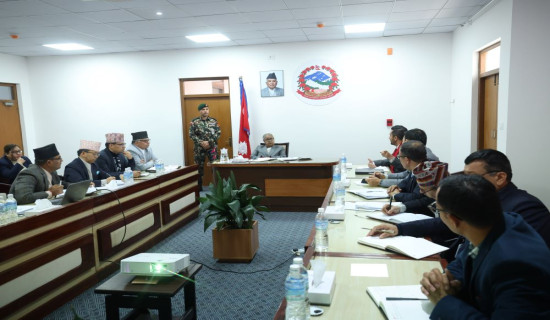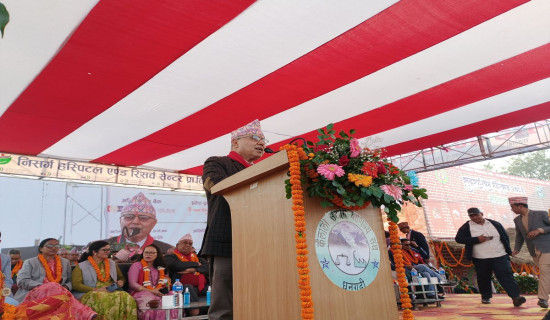- Tuesday, 9 December 2025
Beware of cyber crooks sharing obscene contents to extort money
Kathmandu, Aug. 7: It was just in May last year when a professor at a reputed university in Kathmandu fell victim to someone who blackmailed to share non-consensual obscene graphic contents to extort money. Left with no choice, the victim approached the Cyber Bureau of the Nepal Police and openly shared all his concerns with specialised officers there.
As the investigation progressed, the police discovered that the professor lived alone and actively used WhatsApp and other social media platforms through which he had become a target of blackmailing for money. Once the perpetrator (especially woman) had gathered detailed information about his personal and family background, she began engaging in private and intimate conversations with him. Upon receiving money, she would gradually undress on video calls, removing as much clothing as the amount sent.
However, the victim had no idea that he was already trapped in a case of sextortion. All the video interactions requested by the perpetrator were secretly recorded and stored as clips. Later, she began blackmailing the victim using those recordings and demanded a ransom amounting to Rs. 500,000 to 1 million.
Two years ago, a minister of federal government was nearly drawn to a scandal and he, in time, issued a public notice via his social media platforms, urging everyone to stay vigilant and not to trust any videos disseminated through his hacked Facebook account.
Sextortion, one of the many forms of cybercrime, is increasingly prevalent in Nepali society today. Perpetrators typically begin by gathering detailed information about an individual’s familial and social background through social media platforms like Facebook, WhatsApp, TikTok, and Instagram. Gradually, they establish contact by posing as an acquaintance or potential connection, eventually targeting the individual as a victim.
According to Superintendent of Police (SP) Deepak Raj Awasthi at the Cyber Bureau of the Nepal Police, data indicates that the majority of sextortion victims currently are men, with a relatively smaller proportion being women.
“Those most frequently victimised include individuals in the teaching profession, some members of the security agencies, administrative personnel, and certain segments of the youth population,” SP Awasthi said.
Sextortion can broadly be defined as a criminal manipulation wherein victims are coerced, often through the threat of releasing sensitive or explicit materials into providing money, favours, or further compromising content.
According to SP Awasthi, perpetrators of such crimes typically send out a large number of friend requests. Once someone accepts, they analyse the user’s profile and target them based on their background. The offender initiates a conversation via phone or Messenger, beginning with polite and respectful exchanges on Facebook. Eventually, they request the victim’s WhatsApp number and initiate a video call, police explained.
Recently, even media professionals and individuals with strong computer literacy have fallen victim to these schemes. Digital literacy alone is no longer sufficient, social media users must now exercise heightened awareness and caution themselves, suggested the Bureau.
SP Awasthi advised users not to hastily accept unsolicited friend requests or click on unknown web links. Only accept requests from people you know personally. Moreover, if a profile is locked or lacks transparency, it is best to refrain from accepting the request altogether, suggested the police.
A total of 18,926 cybercrime cases were registered at the Cyber Bureau over the past 12 months, an average of around 52 cases per day.
On paper, the figure is slightly lower than last year’s 19,730. But according to the Bureau, the drop in the official number doesn’t necessarily signal improvement. Instead, the dip may reflect underreporting, data lags, or the decentralisation of case management to the district-based police offices.
While cyber fraud leads the past one-year record (mid-July 2024 to mid-July 2025), the Bureau logged thousands of other offences, 3,503 accounts hacked, 3,067 fake or impersonated accounts created, 1,801 bullying and harassment complaints, 1,026 cases of criminal defamation, and 495 hate speech reports.
Sexual offences included 437 sexting cases, 84 reports of sextortion, and eight reports of sex crimes or sexual assault. Other cases were -- 10 related to suicide, 216 involving threats of violence, and 27 involving image morphing, often forms of digital abuse affecting women, according to the Bureau record.
Facebook and Messenger topped the list with 9,829 incidents, followed by TikTok (3,086), WhatsApp (2,305), Telegram (1,509), and Instagram (1,115).
“Telegram caused significant harm in a short period,” Awasthi noted. “Out of the 1,509 Telegram-related cases, most were online frauds. But the real problem is we didn’t get user data from Telegram for tracking those.” Recently, the government also put a restriction on Telegram.
















